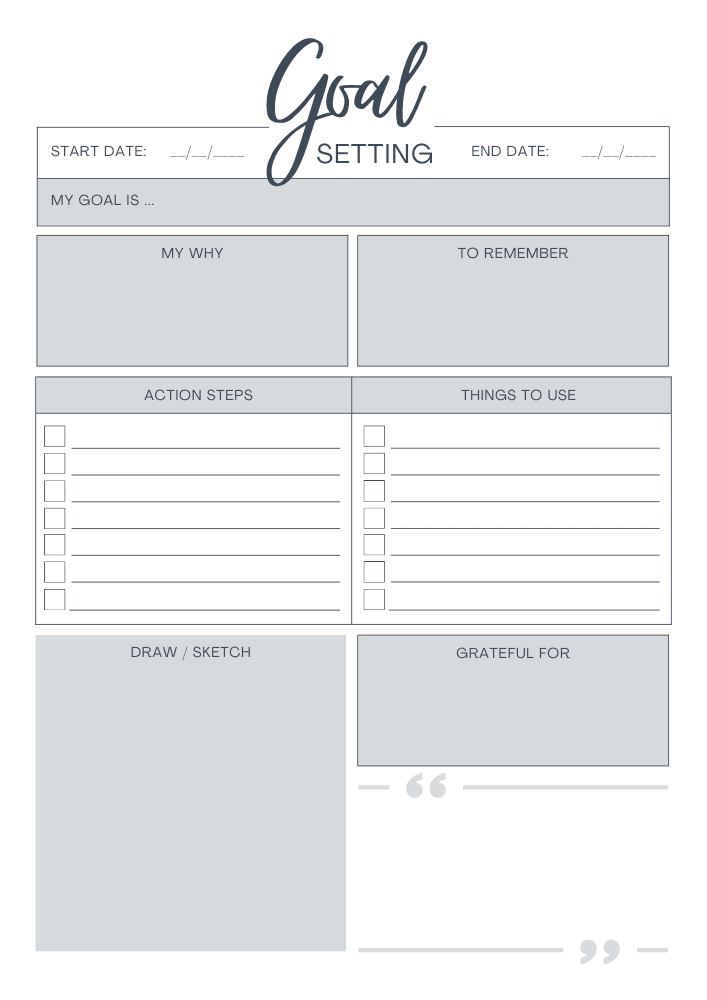Last Updated on February 27, 2024 by Jen
Tracking your personal goals in a notebook isn’t just about listing your aspirations; it’s a practical and rewarding method to visualize your progress, maintain motivation, and achieve personal growth. The tactile nature of handwriting and the personalized touch of a notebook can significantly increase your commitment to your goals.
The Benefits of Goal Tracking in a Notebook
- A Tangible Record: Seeing your goals and progress in writing provides a powerful visual reminder of where you started and how far you’ve come.
- Increased Accountability: Writing down your goals makes them more real and helps you stay committed to achieving them.
- Motivational Tool: Observing your achievements in writing motivates you to continue pushing toward your goals.
- Encourages Reflection: Regularly reviewing your written goals encourages introspection on what’s working and what isn’t.
- Seeing Personal Growth: Looking back at your notebooks from past years helps you to see the personal growth you have made in line with your goals.
Using The Right Notebook For Goal Tracking
Choosing the right notebook for goal tracking significantly enhances the process, and one with removable pages, such as the Happy Planner, stands out as a quintessential tool.
This feature offers unparalleled flexibility, allowing you to customize and adjust your layout as your goals evolve over time.
It means you can remove pages that no longer serve your purpose or add in new ones for fresh objectives without disrupting the structure of your planning.
This adaptability is crucial, as the path to achieving goals often requires adjustments and re-evaluation.
Additionally, the ability to rearrange sections means you can group similar goals together, improving organization and focus.
The Happy Planner, with its customizable design, not only accommodates your changing aspirations but also encourages a dynamic approach to goal management.
Buy A Goal Setting Notebook
You can easily grab a blank notebook and make it your own, but there are also man goal setting notebooks out there for you to buy. They are formatted in a way to help you create and keep track of goals. Check out some on Amazon here.
Guide To Setting And Tracking Goals in Your Notebook
If you choose to use a blank notebook to keep track of your goals, following are some helpful ideas to make the most of it.
1. Dedicate Space for Your Goals
To get the most out of your goal tracking, dedicate a special section in your notebook that serves as your “Goals Sanctuary”.
This doesn’t mean you need a separate notebook; instead, carve out a clear space that’s easily identifiable. You could use the first few pages or a specific section in the middle. Make it visually distinct by decorating the margins, using colorful tabs, or even a bit of washi tape to mark the section.
This space is where you’ll brainstorm, write down your aspirations, and reflect on your progress. The key is to keep your goals visible but organized, allowing you room to add new goals, make adjustments, and track your achievements over time.
By creating a dedicated area, you help ensure that your objectives are not only set but seen and pursued daily.
2. Define Your Goals Using the SMART Criteria
When defining your goals, think of them as your personal road map to success. It’s not enough just to have an idea of what you want; your goals need to be clear and actionable. That’s where the SMART criteria come in, transforming your aspirations into tangible targets.
- S stands for Specific: Be as clear as possible about what you want to achieve. Instead of saying, “I want to be healthier,” specify how, like “I plan to jog three times a week for 30 minutes.”
- M is for Measurable: Ask yourself, how will you know when you’ve achieved your goal? With the jogging example, it’s easy to track – either you do it, or you don’t.
- A means Achievable: Your goal should stretch your abilities but remain possible. If you’ve never jogged before, running a marathon next month might be a bit too ambitious.
- R stands for Relevant: Make sure your goal matters to you and aligns with your other efforts in life. There’s no point in aiming to jog three times a week if, deep down, you hate jogging and prefer cycling.
- T is Time-bound: Set a deadline. Having a “due date” creates a sense of urgency that can spur you into action. Decide when you’ll start and when you hope to have incorporated this habit into your life regularly.
Grab your favorite pen and jot down your goals in your notebook using these criteria. It might feel a bit formal at first, but this clarity is a powerful tool to help you move from dreaming to doing. Remember, the magic happens outside your comfort zone, and your notebook is just the beginning of that journey.
3. Write Goals in the Present Tense
Writing goals in the present tense in your notebook acts as a powerful psychological tool that fosters a sense of immediacy and ownership.
This technique tricks your brain into believing that the achievement of your goal is already underway, which increases your commitment and motivation towards making it a reality.
For instance, stating “I run three times a week” instead of “I will run three times a week” subconsciously aligns your mindset with that of someone who has already incorporated this habit into their lifestyle.
This method not only enhances your belief in your ability to achieve the goal but also serves as a constant reminder of your commitment every time you review your objectives.
4. Break Down Each Goal
Breaking down each goal into smaller, manageable parts can be a game-changer in your goal-setting strategy!
Starting with the end in mind and working backwards can significantly improve how you approach your goals.
Picture your main goal as the final destination on a map. From there, trace your steps back to your current location.
This reverse engineering method helps you identify all the critical milestones you need to hit on your way to the big goal.
For example, if your objective is to run a marathon, working backwards might reveal that you first need to consistently run shorter distances, improve your diet, and invest in the right gear.
By mapping out these steps, you create a more detailed and actionable plan that outlines what needs to be accomplished and when.
This approach not only makes your main goal appear more achievable but also provides clear direction and a structured timeline for your efforts.
5. Regular Reviews and Updates
Setting regular reviews and updates for your goal notebook is akin to giving your goals a health checkup! It’s essential to keep your objectives in alignment with your evolving aspirations and circumstances. Here’s how to do it:
Firstly, schedule a recurring appointment with yourself, preferably on a weekly or bi-weekly basis. During this time, pull out your goal notebook and go through each goal. Reflect on the progress you’ve made and any challenges you’ve faced.
Are you closer to your mini milestones than you were last time?
Is there a new obstacle that wasn’t there before?
This is the time to celebrate successes, no matter how small, and to re-strategize if certain goals seem stagnant.
Next, make any necessary adjustments. Life happens, and sometimes our initial plans need to pivot.
Update your goals and the steps needed to achieve them based on your current situation. Perhaps a goal has become less relevant, or you’ve discovered a more effective route to your destination. Adjusting your plans is not a sign of failure but a sign of flexibility and resilience.
Lastly, refresh your motivation. After each review, write down why these goals are important to you. Remind yourself of the big picture and the feelings you’ll experience when you achieve your goals. This personal touch will reinvigorate your determination and keep your notebook a vibrant and dynamic tool in your success arsenal.
Remember, your goal notebook is a living document, meant to grow and change as you do. Regular reviews ensure that it remains a faithful companion on your personal and professional growth journeys.
6. Engage In Visual Progress Tracking
Visual progress tracking is a powerful tool that harnesses the human brain’s affinity for images, making the path towards your goals not just measurable but visually stimulating. Incorporating visual templates into your goal notebook can significantly enhance your motivation and clarity on the progress you’re making.
Again, this is why something like The Happy Planner is beneficial. It allows you to add pages and remove pages when you want.
Select a visual template that resonates with your personal style and the nature of your goals. This could be a simple bar chart to fill in as you progress, a line graph for quantitative goals, or even a monthly planner template. The key is to choose a format that makes it easy and enjoyable for you to update and review.
Whenever you conduct your regular goal review, take the time to update these visual trackers with any progress made. Color-code different aspects of your goals for a clearer overview at a glance. For example, use different colors for completed tasks, ongoing efforts, and upcoming steps.
Finally, ensure your visual progress trackers are placed where you’ll see them often, preferably at the beginning of your goal notebook or on a wall by your workstation. The constant visual reminder of your progress will serve as a continuous source of motivation, keeping your enthusiasm alive and your focus sharp on the path to achieving your aspirations.
7. Celebrate Your Successes
Celebrating your successes, big or small, is a vital aspect of the goal-setting process, acting as a powerful incentive for continued effort and dedication.
In your goal notebook, create a dedicated section for recording and commemorating your achievements. Whenever you reach a milestone, no matter the scale, take the time to document it in this section.
Describe what the achievement was, the date it occurred, and how you felt at that moment. You can even include photographs or other mementos that capture the essence of your success.
Additionally, consider setting aside a small reward for each milestone achieved, such as a favorite treat, a leisure activity, or a small purchase you’ve been looking forward to. This practice not only serves to recognize and validate your hard work but also creates a repository of positive reflections that can uplift and motivate you, especially during challenging periods.
Celebrating your successes in such a tangible manner enriches your goal-setting journey, making it a more enjoyable and fulfilling experience.
8. Keep Your Notebook Visible
Keeping your goal notebook visible and accessible at all times is crucial to maintaining focus and motivation.
Choose a spot where you frequently spend your time, such as your desk, nightstand, or kitchen counter, ensuring it becomes a part of your daily environment.
The visibility of the notebook acts as a constant reminder of your goals and the commitments you’ve made to yourself.
By having your goals accessible no matter where you are, you create opportunities to review and update your progress throughout the day, reinforcing your dedication and adapting as necessary to stay on track.
9. Share Your Goals for Extra Accountability
Consider sharing your goals with someone you trust. This adds an additional layer of motivation and support.
Unique Ways To Use Your Notebook To Keep Track of Your Personal Goals
Everyone’s goal notebook is different. There are so many different ways you can create and upkeep your goal notebook. Pick what inspires you the most to help you visualize and work towards your goals.
Create a Vision Board
Cut out pictures and words from magazines, print images that represent your goals, and glue them onto the pages of your notebook. This visual representation serves as a powerful reminder of what you want to achieve.
Write Daily Affirmations
Include positive affirmations related to your personal goals in your daily journaling routine. These self-affirmations can help boost your confidence and keep you motivated.
For instance, if you have a goal to make $10,000 a month, you can write affirmations, such as:
- I am capable and deserving of making $10,000.
- Every step I take is bringing me closer to earning $10,000.
- I attract financial success and opportunities with ease.
- I am a powerful money magnet, drawing $10,000 into my life.
- My actions are intentional, and they lead me to a $10,000 success.
Use Inspirational Prompts
Include daily or weekly prompts in your notebook to inspire new ideas and keep you focused on your goals. These prompts can include thought-provoking questions, inspiring quotes, or even simple tasks to help you stay on track.
For instance, if you have a goal to make $10,000 a month, inspirational prompts might be:
- What new skills can I learn to increase my income?
- Who can I reach out to for mentorship or guidance in achieving my financial goals?
- How have I overcome challenges and setbacks in the past, and how can I apply these lessons to achieve $10,000 a month?
Brainstorm Solutions
When faced with challenges or obstacles, your notebook can become a creative haven for finding solutions.
Start by dedicating a page to the specific problem you are encountering. Write it down in clear terms at the top of the page.
Below this, draw a mind map or a brainstorming web. Begin with your main problem in the center and draw lines outward to potential solutions or ideas.
Don’t censor yourself—write down anything that comes to mind, no matter how far-fetched it may seem. Sometimes, the most creative and effective solutions come from what initially appears to be a wild idea.
Additionally, use colors and stickers to make the brainstorming process more engaging and visually stimulating. This method not only helps in organizing your thoughts but also makes the problem-solving process more enjoyable and less daunting.





